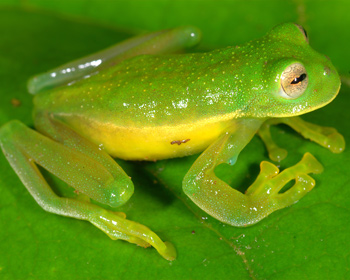Despite global amphibian decline, number of known species soars
Publicity over the past 25 years about the decline of amphibians worldwide has led to an explosion of research on the causes and exploration to find new species. AmphibiaWeb now counts 7,000 amphibian species, up from 5,000 a mere 12 years ago.

July 30, 2012
Publicity over the past 25 years about the decline of amphibians worldwide has had one positive effect: More and more biologists began scouring the planet for new or lost species of frogs and salamanders and found thousands more. Nearly 3,000 new ones have been discovered, raising the number of known species to 7,000, an increase of nearly 75 percent.

The 7,000th amphibian catalogued on AmphibiaWeb is a small (31 mm) Amazonian glass frog (Centrolene sabini). The delicate animal calls from trees above fast-flowing streams in humid, cool, montane forests at elevations of around 9000 feet. Photo by Alessandro Catenazzi.
“In the middle of all the doom and gloom we hear about amphibians, we’re finding them at a faster rate,” said David Wake, professor emeritus of integrative biology at the University of California, Berkeley, and one of the first to raise the alarm about declining amphibian populations. “In many parts of the world, amphibians are doing very well, and there are certainly many yet to be discovered.”
Currently, a new species of amphibian is described in the scientific literature every 2.5 days, he said. The new data come from AmphibiaWeb, a project Wake instituted in 2000 to catalogue the world’s amphibians and simultaneously to encourage more field monitoring and lab studies of amphibians.
“In 1985, there were a handful of amphibian biologists in the whole world,” he said. Drawing attention to the dire plight of amphibians that are threatened by a warming Earth, increasing population, widespread use of pesticides and a deadly fungus led to an explosion of interest in the animals and in the field of herpetology, in general.
“Now, the numbers have increased dramatically, and we are getting to the ends of the earth,” he added.
Nevertheless, about 41 percent of amphibian species are at risk of extinction, according to a June 2012 assessment by the International Union for the Conservation of Nature and Natural Resources (IUCN), and some are already extinct. The IUCN has identified amphibians – frogs, salamanders and caecilians – as the major taxon at greatest risk of extinction.
In 2000, when AmphibiaWeb was launched, about 5,000 species of amphibians had been catalogued, versus 7,000 today. To date, more than 25,000 photos of amphibians have been uploaded to AmphibiaWeb, and scientists query the site between 15,000 and 20,000 times per day.
“We are the place for accurate, vetted information on amphibians,” Wake said, noting that the site, which started as a class project, has such dedicated followers that one recently recorded the AmphiaWeb Song.
In the first seven months of 2012, three new species a week were posted to AmphibiaWeb for a total of 100 new species this year. Most of the new species, however, have yet to be carefully evaluated. They are poorly known, often only from a single population, and many are from areas with limited habitat that are under intense pressure from land conversion and other factors, Wake said.
The newest hotspot of amphibian discovery is South Asia. “South and tropical India is a veritable wonderland of new species of frogs, which is a surprise,” he said, “because we assumed the British did a thorough job (of describing species). Now, we have a thriving Indian amphibian community” exploring the area.
A few years ago, 50 new species of amphibian were discovered in Sri Lanka alone.
Ecuador is still tops in the total number of species per area, said Wake, but new inroads are being made in Papua New Guinea. Recently, Brazil, Peru, India and China have led in describing the most new species.
New species are even found in developed countries. Two new salamanders from California were named earlier this year.
AmphibiaWeb’s 7,000th species is a high elevation glass frog from Manu National Park in Amazonian Peru. Called Centrolene sabini, it was collected by Alessandro Catenazzi and his companions when he was a postdoctoral scholar at UC Berkeley. Catenazzi was first author of a paper describing the species that was co-authored by an international team of scholars including Rudolf von May of UC Berkeley, Edgar Lehr of Illinois Wesleyan University, Giussepe Gagliardi-Urrutia of the Peruvian Center for Biodiversity and Conservation and Juan Guayasamin of the Universidad Technológica Indoamérica in Quito, Ecuador. The frog is a small (31.2 millimeters long), delicate, beautiful animal that calls from trees above fast-flowing streams in humid, cool, montane forests at elevations around 2,800 m (about 9000 ft), Wake said.
AmphibiaWeb’s 25,000th photograph is of a salamander, Bolitoglossa aureogularis, named earlier this year, that lives in the high Cordillera de Talamanca in eastern Costa Rica. The photographer was Eduardo Boza-Oviedo of the Universidad de Costa Rica.
Though Wake is director, AmphibiaWeb is run by an international team that includes associate director Vance Vredenburg of San Francisco State University; Joyce Gross, Michelle Koo and Carol Spencer of UC Berkeley; David Blackburn of the California Academy of Sciences in San Francisco; and David Cannatella of the University of Texas at Austin.
More information:
- AmphibiaWeb
- Scientists document salamander decline in Central America (2/9/09 press release)
- David Wake’s laboratory Web site